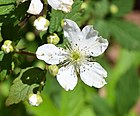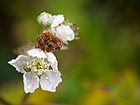Note: This is a project under development. The articles on this wiki are just being initiated and broadly incomplete. You can Help creating new pages.
Difference between revisions of "Rubus sieboldii - Molucca Raspberry"
(Created page with "Rubus sieboldii, the Molucca Raspberry, is a flowering plant in the genus Rubus. The species is native to Australia, and mid-western Asia, in the Himalaya Mountains and foothi...") |
(→References) |
||
| (13 intermediate revisions by 4 users not shown) | |||
| Line 1: | Line 1: | ||
| − | Rubus | + | '''Rubus sieboldi''' is a flowering plant in the genus Rubus family and it is native to Australia, and mid-western Asia, in the Himalaya Mountains and foothills. |
| + | |||
| + | ==Uses== | ||
| + | {{Uses|Menstrual cramps}}, {{Uses|Fever}}, {{Uses|colds}}, {{Uses|Flu}}, {{Uses|Burns}}, {{Uses|varicose veins}}, {{Uses|Conjunctivitis}}, {{Uses|Diarrhea}}, {{Uses|Wounds}} | ||
| + | |||
| + | ==Parts Used== | ||
| + | {{Parts Used|Fruits}}, {{Parts Used|Leaves}}. | ||
| + | |||
| + | ==Chemical Composition== | ||
| + | Cyanidin-3-sophoroside was the most abundant anthocyanin. All quality parameters were significantly affected by genotype. The genotypes could be categorised into three groups. 'Veten' and 'RU984 06038' were characterised by high concentrations of flavonoids<ref name="chemical composition"/> | ||
| + | |||
| + | ==Common names== | ||
| + | {{Common names|kn=|ml=|sa=|ta=|te=|hi=|en=Molucca raspberry}} | ||
| + | |||
| + | ==Properties== | ||
| + | Reference: Dravya - Substance, Rasa - Taste, Guna - Qualities, Veerya - Potency, Vipaka - Post-digesion effect, Karma - Pharmacological activity, Prabhava - Therepeutics. | ||
| + | ===Dravya=== | ||
| + | |||
| + | ===Rasa=== | ||
| + | Tikta (Bitter), Kashaya (Astringent) | ||
| + | ===Guna=== | ||
| + | Laghu (Light), Ruksha (Dry), Tikshna (Sharp) | ||
| + | ===Veerya=== | ||
| + | Ushna (Hot) | ||
| + | ===Vipaka=== | ||
| + | Katu (Pungent) | ||
| + | ===Karma=== | ||
| + | Kapha, Vata | ||
| + | ===Prabhava=== | ||
| + | |||
| + | ==Habit== | ||
| + | {{Habit|Shrub}} | ||
| + | |||
| + | ==Identification== | ||
| + | ===Leaf=== | ||
| + | {{Leaf|Simple||Round, serrated leaves can get up to 22 cm long}}<ref name="Leaf"/> | ||
| + | |||
| + | ===Flower=== | ||
| + | {{Flower|Unisexual|2-4cm long|White|5|5 oval shaped white petals}} | ||
| + | |||
| + | ===Fruit=== | ||
| + | {{Fruit||7–10 mm|Red sweet fruit that is liked by birds and rodents|With hooked hairs|Single}} | ||
| + | |||
| + | ===Other features=== | ||
| + | |||
| + | ==List of Ayurvedic medicine in which the herb is used== | ||
| + | |||
| + | ==Where to get the saplings== | ||
| + | ==Mode of Propagation== | ||
| + | {{Propagation|Seeds}}, {{Propagation|Cuttings}}. | ||
| + | |||
| + | ==How to plant/cultivate== | ||
| + | We have very little information on this species and do not know if it will be hardy in Britain, though judging by its native range it should succeed outdoors in many parts of this country. <ref name="How to plant/cultivate"/> | ||
| + | |||
| + | ==Commonly seen growing in areas== | ||
| + | {{Commonly seen|Low wetland areas}}, {{Commonly seen|Himalaya Mountains}}, {{Commonly seen|Foothills}}. | ||
| + | |||
| + | ==Photo Gallery== | ||
| + | <gallery class="left" caption="" widths="140px" heights="140px"> | ||
| + | |||
| − | |||
| − | + | Blackberries- another potentially invasive species being sold in stores.jpg | |
| − | |||
| − | |||
| − | |||
| − | |||
| − | <references> | + | Blackberry - Rubus species, Brighton Beach, Deep Cove, British Columbia.jpg |
| − | <ref name=" | + | |
| − | <ref name=" | + | |
| + | Blackberry flower UMFS.jpg | ||
| + | |||
| + | |||
| + | Bramble flower (10493504074).jpg | ||
| + | |||
| + | </gallery> | ||
| + | |||
| + | ==References== | ||
| + | |||
| + | <references> | ||
| + | <ref name="chemical composition">[https://www.ncbi.nlm.nih.gov/pubmed/24799233 Chemical comstituents]</ref> | ||
| + | |||
| + | <ref name="Leaf">[http://www.biisc.org/molucca-raspberry/l Plant description]</ref> | ||
| + | |||
| + | <ref name="How to plant/cultivate">[https://pfaf.org/user/Plant.aspx?LatinName=Rubus+sieboldii Cultivation details]</ref> | ||
</references> | </references> | ||
| − | == External Links == | + | ==External Links== |
| − | + | * [https://www.playingwithfire.com.au/indigenous-raspberries.html Rubus sieboldii on playing with fire.com] | |
| − | *[https:// | + | * [https://davesgarden.com/guides/pf/go/31980#b Rubus sieboldii on daves garden] |
| + | * [http://www.hear.org/pier/species/rubus_sieboldii.htm Rubus sieboldii on hear.org] | ||
| + | * [http://eol.org/pages/30108/details Rubus sieboldii on encyclopedea of life] | ||
[[Category:Herbs]] | [[Category:Herbs]] | ||
| + | [[Category:Rosaceae]] | ||
Latest revision as of 15:38, 27 July 2020
Rubus sieboldi is a flowering plant in the genus Rubus family and it is native to Australia, and mid-western Asia, in the Himalaya Mountains and foothills.
Contents
- 1 Uses
- 2 Parts Used
- 3 Chemical Composition
- 4 Common names
- 5 Properties
- 6 Habit
- 7 Identification
- 8 List of Ayurvedic medicine in which the herb is used
- 9 Where to get the saplings
- 10 Mode of Propagation
- 11 How to plant/cultivate
- 12 Commonly seen growing in areas
- 13 Photo Gallery
- 14 References
- 15 External Links
Uses
Menstrual cramps, Fever, colds, Flu, Burns, varicose veins, Conjunctivitis, Diarrhea, Wounds
Parts Used
Chemical Composition
Cyanidin-3-sophoroside was the most abundant anthocyanin. All quality parameters were significantly affected by genotype. The genotypes could be categorised into three groups. 'Veten' and 'RU984 06038' were characterised by high concentrations of flavonoids[1]
Common names
| Language | Common name |
|---|---|
| Kannada | |
| Hindi | |
| Malayalam | |
| Tamil | |
| Telugu | |
| Marathi | NA |
| Gujarathi | NA |
| Punjabi | NA |
| Kashmiri | NA |
| Sanskrit | |
| English | Molucca raspberry |
Properties
Reference: Dravya - Substance, Rasa - Taste, Guna - Qualities, Veerya - Potency, Vipaka - Post-digesion effect, Karma - Pharmacological activity, Prabhava - Therepeutics.
Dravya
Rasa
Tikta (Bitter), Kashaya (Astringent)
Guna
Laghu (Light), Ruksha (Dry), Tikshna (Sharp)
Veerya
Ushna (Hot)
Vipaka
Katu (Pungent)
Karma
Kapha, Vata
Prabhava
Habit
Identification
Leaf
| Kind | Shape | Feature |
|---|---|---|
| Simple | Round, serrated leaves can get up to 22 cm long |
Flower
| Type | Size | Color and composition | Stamen | More information |
|---|---|---|---|---|
| Unisexual | 2-4cm long | White | 5 | 5 oval shaped white petals |
Fruit
| Type | Size | Mass | Appearance | Seeds | More information |
|---|---|---|---|---|---|
| 7–10 mm | Red sweet fruit that is liked by birds and rodents | With hooked hairs | Single | {{{6}}} |
Other features
List of Ayurvedic medicine in which the herb is used
Where to get the saplings
Mode of Propagation
How to plant/cultivate
We have very little information on this species and do not know if it will be hardy in Britain, though judging by its native range it should succeed outdoors in many parts of this country. [3]
Commonly seen growing in areas
Low wetland areas, Himalaya Mountains, Foothills.
Photo Gallery
References
External Links
- Ayurvedic Herbs known to be helpful to treat Menstrual cramps
- Ayurvedic Herbs known to be helpful to treat Fever
- Ayurvedic Herbs known to be helpful to treat colds
- Ayurvedic Herbs known to be helpful to treat Flu
- Ayurvedic Herbs known to be helpful to treat Burns
- Ayurvedic Herbs known to be helpful to treat varicose veins
- Ayurvedic Herbs known to be helpful to treat Conjunctivitis
- Ayurvedic Herbs known to be helpful to treat Diarrhea
- Ayurvedic Herbs known to be helpful to treat Wounds
- Herbs with Fruits used in medicine
- Herbs with Leaves used in medicine
- Herbs with common name in English
- Habit - Shrub
- Index of Plants which can be propagated by Seeds
- Index of Plants which can be propagated by Cuttings
- Herbs that are commonly seen in the region of Low wetland areas
- Herbs that are commonly seen in the region of Himalaya Mountains
- Herbs that are commonly seen in the region of Foothills
- Herbs
- Rosaceae



